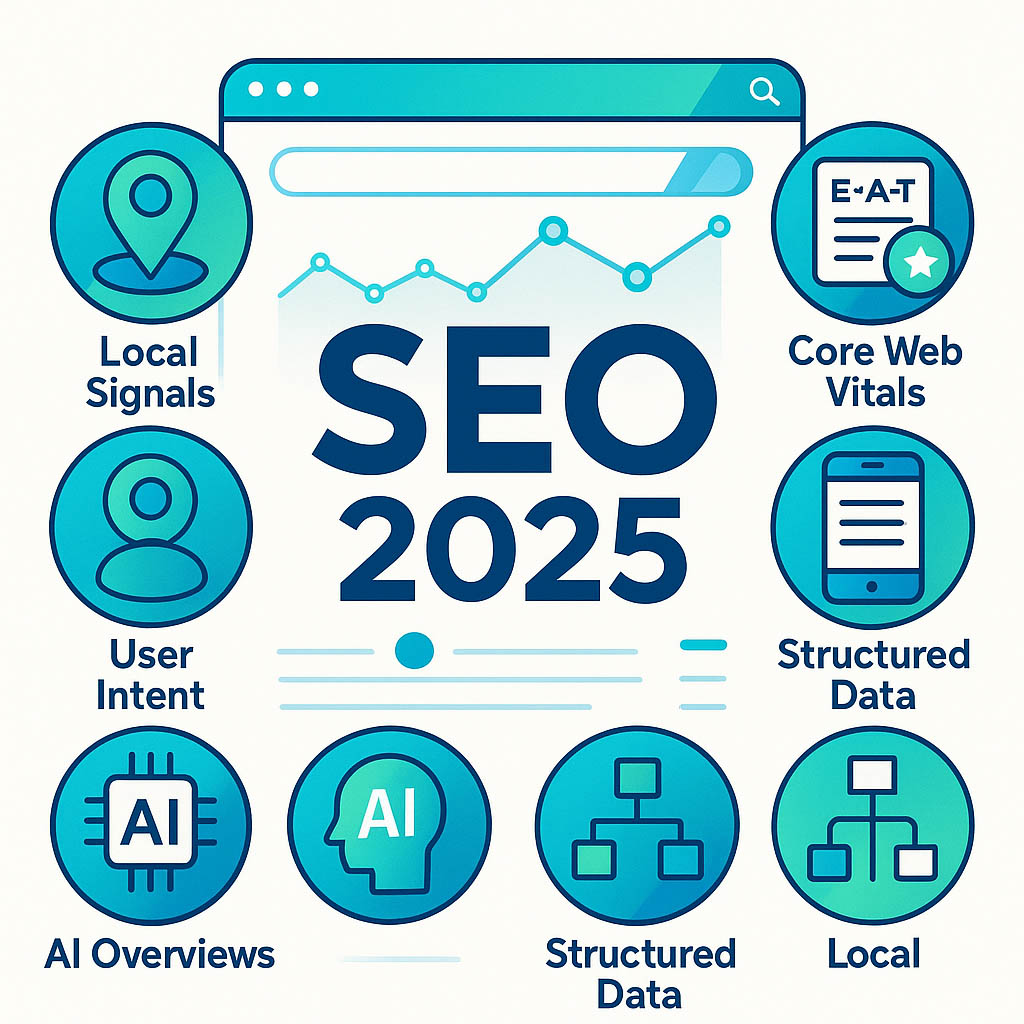Search engines now lean on hundreds of signals, but the nine factors below dominate visibility today. Each combines long-standing fundamentals with 2024-25 algorithm changes.

1. Helpful, People-First Content + E-E-A-T
Google’s “Helpful Content” system, baked into the core ranking pipeline, rewards pages that genuinely solve a query and demonstrate Experience, Expertise, Authoritativeness & Trustworthiness (E-E-A-T). Google’s own guidelines urge creators to self-audit against those pillars.
Action points
- Publish from real practitioners (show bios, credentials, first-hand data).
- Provide original research, screenshots, or test results—material a language model can’t hallucinate.
- Keep YMYL topics (health, finance, safety) doubly referenced and fact-checked.
2. Search Intent & Behaviour Signals (NavBoost)
Leaked documentation confirms Google re-orders results with click-stream data via the NavBoost system. High pogo-stick rates, short dwell time or low CTR can sink a page even if it is “technically” optimised.
Action points
- Audit the live SERP before writing—match its dominant format (video, listicle, product grid).
- Place the answer or product USP above the fold; use jump-to links or an on-page table of contents.
- Improve micro-UX: intuitive headings, readable line length, fast interactive elements.
3. Domain Authority & Backlinks
Quantity matters far less than context: links from niche-relevant, high-trust sites correlate strongly with top positions, while manipulative patterns trigger manual actions or algorithmic discounting
Action points
- Earn links via original studies, data visualisations, and digital PR instead of bulk purchases.
- Monitor toxic links and disavow them quarterly.
- Track brand mentions without links—Google increasingly treats them as partial authority signals.
4. Page Experience & Core Web Vitals (LCP, CLS, INP)
Interaction to Next Paint (INP) replaced FID in March 2024, measuring true interface responsiveness. Pages outside the “good” thresholds increasingly drop in mobile results.
| Metric | Target |
|---|---|
| Largest Contentful Paint (LCP) | < 2.5 s |
| Cumulative Layout Shift (CLS) | < 0.1 |
| Interaction to Next Paint (INP) | < 200 ms |
Action points
- Serve images in AVIF/WebP, defer non-critical JavaScript, and stream critical CSS inline.
- Use priority hints (
<link rel=preload>) for hero media and fonts.
5. Mobile-First & Technical Hygiene
Google completed its mobile-first index migration in Oct 2023, so the smartphone crawler is canonical. HTTPS, canonical tags, XML sitemaps and minimal 4xx/5xx errors remain baseline trust signals.
6. Structured Data & Machine Readability
Schema.org markup feeds knowledge graphs, rich snippets and, crucially, generative answer engines that “quote” trustworthy sources. Sites using comprehensive, valid JSON-LD see higher rich-result CTR and better entity understanding.
Action points
- Mark up FAQs, HowTo, Product, and Review entities; validate in Search Console’s Rich Results test.
- Embed clear publisher microdata (
Organization,Author) to reinforce E-E-A-T.
7. Optimising for Generative Answer Engines
Google AI Overviews and Yandex Neuro lift passages directly into LLM summaries. They favour concise, fact-dense paragraphs, lists, and tables with explicit attribution.
Action points
- Use question-answer blocks, checklists, TL;DR boxes.
- Keep facts current and cite primary sources; inconsistent data risks hallucinated summaries.
- Track not just clicks but appearance frequency in overviews.
8. Local & Semantic Signals
For brick-and-mortar and service-area businesses, a complete Google Business Profile (NAP accuracy, reviews, fresh photos) plus location-oriented schema strongly influences the “local pack.”
9. Freshness & Core Updates
The March 2025 Core Update (13 – 27 Mar) showed Google’s ongoing fight against thin AI-generated pages and duplicate content. Expect quarterly core refreshes that reassess site-wide quality.
2025 SEO Priority Checklist
- Craft expert-led, people-first content in the preferred SERP format.
- Meet Core Web Vitals—especially INP—and test on real devices.
- Deploy complete structured data and validate regularly.
- Build contextual backlinks through PR, research and partnerships.
- Optimise titles and layouts for rapid intent fulfilment to earn favourable NavBoost signals.
- Maintain a bullet-proof mobile experience (HTTPS, clean crawl paths).
- Monitor AI Overview/Neuro visibility and refine content nuggets for quoting.
- Keep local profiles, reviews and citations up-to-date if geography matters.
- Review analytics after every core update and refresh under-performing pages.
Focus on content for people, structure for machines, and speed for everyone that balance is the real ranking moat in 2025. For a deeper dive into the link-building side of SEO, check out our full guide to the most valuable backlinks and learn exactly why .edu and .gov links still carry outsized authority. When you’re ready to put theory into action, follow our step-by-step blueprint for earning .edu backlinks for free.
